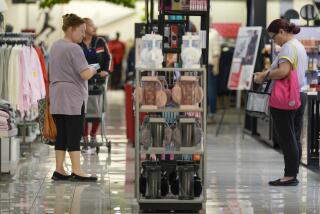Shoppers Respond to Improving Weather
- Share via
WASHINGTON — Consumers, locked in by severe weather in January, celebrated their release a month later with a buying binge and a return to their jobs that helped boost income by the largest amount in a year.
At the same time, orders to U.S. factories suffered the steepest decline in 10 months. But analysts on Wednesday noted that when the volatile transportation sector was excluded, orders rose for the third straight month.
Richard Berner, an economist with Mellon Bank in Pittsburgh, said Wednesday’s government reports combined with other data suggest “the economy is accelerating, growing moderately.” But he added, “It’s certainly not a boom.”
The Commerce Department said consumer spending shot up 1.1% in February, to a seasonally adjusted $5.07-trillion annual rate. It was the steepest advance since a 1.7% gain two years earlier.
Spending had fallen 0.4% in January, the first decline in three months, as the East Coast blizzard and other storms kept many shoppers shuttered inside.
Berner acknowledged that part of the subsequent increase was a rebound and said “that kind of growth is not sustainable.” But he added that the data also show “some underlying strength there as well.”
And economists at Donaldson, Lufkin & Jenrette Securities Corp. noted that the January-February average was 1% above the average spending during the entire fourth quarter.
Since consumer spending represents about two-thirds of the nation’s economic activity, analysts said the report sets the stage for moderately stronger economic growth in the second quarter.
The report also showed that personal incomes rose 0.8%, to a $6.3-trillion rate, the fastest increase since a 0.9% advance in January 1995.
Although that largely reflected employees returning to work, Donaldson, Lufkin & Jenrette said average earnings in January and February were also 1% above the fourth-quarter pace.
*
In its other report, the Commerce Department said orders for both durable and nondurable goods fell 1.4%, to a seasonally adjusted $304.4 billion. It was the second decline in three months and the steepest since a 2.2% drop last April.
But the weakness was concentrated in transportation, which fell 11.7% due mostly to a lack of orders for commercial aircraft. Excluding this volatile sector, orders rose 0.2%.
Orders are considered a key gauge of the nation’s manufacturing strength and an increase could lead to greater production and more jobs.
Orders for durable goods, which include airplanes and other items expected to last more than three years, fell 2.3%, slightly less than the government’s 2.5% initial estimate last week. They had fallen 0.6% in January after rising 3.1% at year’s end.
Also holding back orders was the often-volatile military component, which sank 27.9% after rising 4.9% in January and 36.7% in December. Excluding this category, orders were down just 0.8%.
(BEGIN TEXT OF INFOBOX / INFOGRAPHIC)
Factory Orders
Seasonally adjusted total new orders, in billions of dollars:
Feb.1996: $304.4
Source Commerce Department
More to Read
Inside the business of entertainment
The Wide Shot brings you news, analysis and insights on everything from streaming wars to production — and what it all means for the future.
You may occasionally receive promotional content from the Los Angeles Times.










